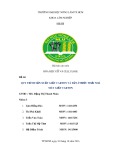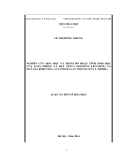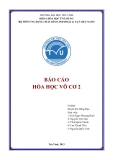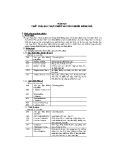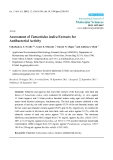EURASIP Journal on Applied Signal Processing 2005:6, 972–980 c(cid:1) 2005 Hindawi Publishing Corporation
Carrier and Clock Recovery in (Turbo-) Coded Systems: Cram ´er-Rao Bound and Synchronizer Performance
N. Noels Department of Telecommunications and Information Processing (TELIN), Ghent University, Sint-Pietersnieuwstraat 41, 9000 Ghent, Belgium Email: nnoels@telin.ugent.be
H. Steendam Department of Telecommunications and Information Processing (TELIN), Ghent University, Sint-Pietersnieuwstraat 41, 9000 Ghent, Belgium Email: hs@telin.ugent.be
M. Moeneclaey Department of Telecommunications and Information Processing (TELIN), Ghent University, Sint-Pietersnieuwstraat 41, 9000 Ghent, Belgium Email: mm@telin.ugent.be
Received 30 September 2003; Revised 26 May 2004
In this paper, we derive the Cram´er-Rao bound (CRB) for joint carrier phase, carrier frequency, and timing estimation from a noisy linearly modulated signal with encoded data symbols. We obtain a closed-form expression for the CRB in terms of the marginal a posteriori probabilities of the coded symbols, allowing efficient numerical evaluation of the CRB for a wide range of coded systems by means of the BCJR algorithm. Simulation results are presented for a rate 1/2 turbo code combined with QPSK mapping. We point out that the synchronization parameters for the coded system are essentially decoupled. We find that, at the normal (i.e., low) operating SNR of the turbo-coded system, the true CRB for coded transmission is (i) essentially the same as the modified CRB and (ii) considerably smaller than the true CRB for uncoded transmission. Comparison of actual synchronizer performance with the CRB for turbo-coded QPSK reveals that a “code-aware” soft-decision-directed synchronizer can perform very closely to this CRB, whereas “code-unaware” estimators such as the conventional non-data-aided algorithm are substantially worse; when operating on coded signals, the performance of the latter synchronizers is still limited by the CRB for uncoded transmission.
Keywords and phrases: carrier recovery, clock recovery, coded systems, Cram´er-Rao bound, synchronizer performance.
1. INTRODUCTION
been derived in [2, 3]. The MCRB is much simpler to evalu- ate than the CRB but is, in general, looser (i.e., lower) than the CRB, especially at low SNR. In [4, 5, 6, 7], the CRB for the estimation of carrier phase, carrier frequency, and tim- ing delay from uncoded data symbols has been obtained and discussed. In [8], the CRB for carrier phase estimation from coded data has been expressed in terms of the marginal a pos- teriori probabilities (APPs) of the coded symbols.
The impressive performance of turbo receivers implicitly as- sumes perfect synchronization, that is, the carrier phase, fre- quency offset, and time delay must be recovered accurately before data detection. Synchronization for turbo-encoded systems is yet a very challenging task since the receiver usu- ally operates at extremely low SNR values. The development of accurate synchronization techniques has therefore recently received a lot of attention in the technical literature.
In this contribution, we derive the CRB for joint carrier phase, carrier frequency offset, and timing recovery in coded systems. Again we obtain a closed-form expression for the CRB in terms of the marginal APPs, allowing the numerical evaluation of the bound for a wide range of coded systems, including schemes with iterative detection (turbo schemes). This CRB is evaluated for rate 1/2 turbo-coded QPSK, and compared to (i) the MCRB, (ii) the CRB for uncoded A common approach to judge the performance of param- eter estimators is to compare their resulting mean square er- ror (MSE) with the Cram´er-Rao bound (CRB), which is a fundamental lower bound on the error variance of unbiased estimators [1]. In order to avoid the computational com- plexity related to the true CRB, a modified CRB (MCRB) has
(Turbo-) Coded Systems: CRB and Synchronizer Performance 973
K(cid:6)
With u = (u1, u2, u3) = (θ, F, τ) and v = a, the joint likelihood function p(r|v; u) resulting from (2) is Gaussian, with a mean depending on (u, v) and a covariance matrix that is independent of (u, v). Within a factor not depending on (u, v), p(r|v; u) is given by
(cid:3) (cid:2) ak, ˜zk(θ, F, τ) ,
k=−K
transmission, and (iii) the MSE of some practical synchro- nizers. Our results point out that, at the normal operating SNR of the turbo code, (i) the CRB is essentially the same as the MCRB, (ii) the CRB is significantly smaller than the CRB for uncoded transmission, and (iii) the CRB is a tight lower bound on the MSE resulting from the joint synchronization and turbo-decoding scheme the authors proposed in [9]. (3) p(r|v; u) = p(r|a; θ, F, τ) = F
(cid:7)
(cid:2)
(cid:8)
−
= exp
(cid:2) 2 Re
2. PROBLEM FORMULATION where
(cid:11) (cid:10) (cid:10)2(cid:3) .
(cid:3) ak, ˜zk(θ, F, τ)
(cid:10) (cid:10)ak
(cid:9) a∗ k ˜zk(θ, F, τ)
F Es N0 (4)
(cid:12)
In (3), r is a vector representation of the signal r(t) from (2), and ˜zk(θ, F, τ) = zk(F, τ)e− jθ, where zk(F, τ) is defined as
(cid:4) (cid:3)
(cid:2)
(cid:1) − ∂2
(5) e− j2πFtr(t)h(t − kT − τ)dt. zk(F, τ) = Consider an observation vector r with a probability density function p(r; u) that depends on a deterministic vector pa- rameter u. Suppose that from the observation r, one is able to produce an unbiased estimate ˆu of the parameter u, that is, Er[ ˆu] = u for all u; the expectation Er[·] is with respect to p(r; u). Then the estimation error variance is lower bounded by the CRB [1]: Er[( ˆui − ui)2] ≥ CRBi(u), where CRBi(u) is the ith diagonal element of the inverse of the Fisher informa- tion matrix (FIM) J(u). The (i, j)th element of J(u) is given by
(cid:1)
(cid:2)
(cid:2)
ln p(r; u) Ji, j(u) = Er ∂ui∂u j (1)
(cid:4) (cid:3) .
= Er
(cid:3) ∂ ∂u j
ln ln p(r; u) p(r; u) ∂ ∂ui Note that ˜zk(θ, F, τ) is obtained by first frequency-correcting r(t) by an amount −F, then applying the result to a filter that is matched to the transmit pulse h(t) and sampling the matched filter output at instant kT + τ, and finally rotating the resulting sample over an angle −θ. Hence, ˜zk is a func- tion of (θ, F, τ), whereas zk depends only on (F, τ). The log- likelihood function ln(p(r; u)) resulting from (3) is given by
(cid:13)
(cid:14)
K(cid:6)
(cid:2)
ln p(r; u) = ln p(r; θ, F, τ)
= ln
(cid:15)(cid:16) (cid:3) ak, ˜zk(θ, F, τ)
k=−K
(6) The probability density p(r; u) of r, corresponding to a given value of u, is called the likelihood function of u, while ln(p(r; u)) is the log-likelihood function of u. Note that J(u) is a symmetrical matrix. When the element Ji, j(u) = 0, the parameters ui and u j are said to be decoupled. . F Ea
K(cid:5)
(cid:2)
(cid:3)
The expectation Ea[·] in (6) is with respect to the a priori distribution p(a) of the transmitted data sequence a. Com- putation of the CRB requires the substitution of (6) into (1), and the evaluation of the various expectations included in (6) and (1). When the observation r depends not only on the pa- rameter u to be estimated but also on a nuisance vector pa- rameter v, the likelihood function of u is obtained by aver- aging the likelihood function p(r|v; u) of the vector (u, v) over the a priori distribution of the nuisance parameter: p(r; u) = Ev[p(r|v; u)]. We refer to p(r|v; u) as the joint like- lihood function, as p(r|v; u) is relevant to the joint estima- tion of u and v. We consider the complex baseband representation r(t) of a noisy linearly modulated signal:
k=−K
r(t) = j(θ + 2πFt) + w(t), (2) akh(t − kT − τ) exp
(cid:1)
(cid:2)
(cid:4) (cid:3)
− ∂2
The evaluation of the expectations involved in J(θ, F, τ) and p(r; θ, F, τ) is quite tedious. In order to avoid the com- putational complexity caused by the nuisance parameters, a simpler lower bound, called the modified CRB (MCRB), has been derived in [2, 3], that is, Er[( ˆui − ui)2] ≥ CRBi(u) ≥ MCRBi(u), where MCRBi(u) is the ith diagonal element of the inverse of the modified Fisher information matrix (MFIM) JM(u). The (i, j)th element of JM(u) is given by
(cid:1)
(cid:2)
(cid:4) (cid:3)
= Er,v
(cid:3) ∂ ∂u j
ln p(r|v; u) JM i, j(u) = Er,v (7) ln ln p(r|v; u) p(r|v; u) ∂ui∂u j (cid:2) ∂ ∂ui
and Er,v[·] denotes averaging over both r and v, that is, with respect to p(r, v; u) = p(r|v; u)p(v). When p(r|v; u) is Gaussian, (7) is much simpler than (1) as far as analytical evaluation is concerned, because the tedious computation of p(r; u) is avoided. where a = (a−K , . . . , aK ) is a vector of L = 2K + 1 symbols taken from an M-PSK, M-QAM, or M-PAM constellation ac- cording to a combination of an encoding rule and a map- ping rule; h(t) is an even, real-valued unit-energy square-root Nyquist pulse; τ is the time delay; θ is the carrier phase at t = 0; F is the carrier frequency offset; T is the symbol inter- val; w(t) is complex-valued zero-mean Gaussian noise with independent real and imaginary parts, each having a normal- ized power spectral density of N0/(2Es), with Es and N0 de- noting the symbol energy and the noise power spectral den- sity, respectively.
974 EURASIP Journal on Applied Signal Processing
(cid:9)
(cid:8) ( ˆθ − θ)2
K(cid:5)
(cid:2)
(cid:3)
≥ MCRBθ = N0 2EsL
= 2
(cid:3) ,
(cid:2) µ∗ k (˜z)˜z(cid:7),k
(cid:9)
k=−K
(cid:3) ,
(cid:8) ( ˆF − F)2 · T 2
≥ MCRBF =
(cid:9)
The MCRB for joint carrier phase, carrier frequency off- set, and timing estimation, corresponding to r(t) from (1), is given by [2, 3] where Pr[a = ci|r; θ, F,τ] (i = 0, . . . , ML − 1) are the joint symbol a posteriori probabilities (APPs); note from (3) that Pr[a = ci|r; θ, F,τ] is a function of ci and ˜z = (˜z−K , . . . , ˜zK )T only. Using (13) and (3), (12) is transformed into , (8) E ln Re (14) p(r; u) Es N0 ∂ ∂u(cid:7) 3N0 (cid:2) (9) E L2 − 1
(cid:8) ( ˆτ − τ)2/T 2
≥ MCRBτ =
(cid:3)2dt
(cid:2)
(cid:3)
2π2EsL N0 (cid:17) (cid:2) where the subscript (cid:7) denotes differentiation with respect to u(cid:7), that is, , (10) E ˙h(t) 2EsLT 2 (15) ˜zk ˜z(cid:7),k = ∂ ∂u(cid:7)
ML−1(cid:5)
(cid:9)
(cid:17)
and µk(˜z) is the a posteriori average of the symbol ak:
µk(˜z) = (ci)k Pr
(cid:8) a = ci|r; θ, F, τ
i=0 M−1(cid:5)
(cid:8)
(cid:9)
=
(16)
m=0
. αm Pr ak = αm|r; θ, F, τ
where ˙h(t) = dh(t)/dt and L = 2K + 1 denotes the num- ber of symbols transmitted within the observation interval. Note that in (9) and (10), the frequency and timing errors have been normalized by the symbol interval T. The MCRB does not depend on the symbol constellation; the shape of ( ˙h(t))2dt in the transmit pulse h(t) affects only the quantity (10), which is an increasing function of the excess bandwidth of the transmit pulse h(t). The MCRB for phase and timing estimation is inversely proportional to L; the MCRB for fre- quency estimation is, for large L, inversely proportional to L3. In [10], the high-SNR limit of the true CRB related to the estimation of a scalar parameter has been evaluated analyti- cally and has been shown to coincide with the MCRB from (8), (9), and (10).
In (16), (ci)k is the kth component of the vector ci, (α0, α1, . . . , αM−1) denotes the set of constellation points, and Pr[ak = αm|r; θ, F,τ] (m = 0, . . . , M − 1) are the marginal symbol APPs. We emphasize that no approximation is in- volved when arriving at (16). The second line of (16) sim- ply expresses the a posteriori average of ak in terms of the marginal APP of ak, rather than the joint APP of (a−K , . . . , aK ). In the next section, we derive a closed-form expression of the CRB resulting from (1) in terms of the marginal APPs of the coded symbols, allowing efficient numerical evaluation of the CRB.
(cid:13)
3. DERIVATION OF THE CRB Substitution of (14) into (1) yields an exact expression of the FIM in terms of the a posteriori symbol averages µk(˜z), which in turn depend on the marginal symbol APPs Pr[ak = αm|r; θ, F, τ]. One obtains
(cid:16)2 K(cid:5)
K(cid:5)
(cid:8)
(cid:8)
(cid:9)
(cid:8)
(cid:9)(cid:9)
(cid:13)
ML−1(cid:5)
(cid:9)
(cid:16) (cid:3)
k=−K
k(cid:4)=−K
The log-likelihood function ln(p(r; θ, F, τ)) from (6) can be written as Re Re , E Ji, j = 4 µ∗ k (˜z)˜zi,k µ∗ k(cid:4) (˜z)˜z j,k(cid:4) Es N0 Pr , (11) ln p(r; θ, F, τ) = ln p
(cid:8) a = ci
(cid:2) r|ci; θ, F, τ
i=0
(17) where E[·] denotes averaging over the quantities ˜z, ˜zi,k, and ˜z j,k(cid:4). As this averaging cannot be done analytically, we have to resort to a numerical evaluation.
(cid:2)
where p(r|ci; θ, F, τ) is given by (3) and i enumerates all ML symbol sequences ci of length L. Denoting by ξ the set of le- gitimate coded sequences of length L, we have Pr[a = ci] = M−ρL for ci ∈ ξ and Pr[a = ci] = 0 otherwise, with ρ and M denoting the rate of the code and the number of constellation points, respectively. Differentiation of (11) yields
(cid:3) p(r; u)
(cid:9)
(cid:3)
ML−1(cid:5)
(cid:2)
ln ∂ ∂u(cid:7)
Pr
(cid:8) a = ci
(cid:2) r|ci; θ, F,τ
=
(cid:3)(cid:3) .
ln p
(cid:2) r|ci; u
i=0
p p(r; θ, F,τ) ∂ ∂u(cid:7) (12)
(cid:8)
(cid:9)
(cid:3)
Making use of Bayes’ rule, we obtain
Pr a = ci
(cid:2) r|ci; θ, F, τ
= Pr
(cid:9) ,
(13)
(cid:8) a = ci|r; θ, F, τ
A brute force evaluation of the FIM involves replacing in (17) the statistical average E[·] by an arithmetical aver- age over a large number of realizations of (˜z, ˜zi,k, ˜z j,k(cid:4)) that are computer-generated according to the joint distribution of (˜z, ˜zi,k, ˜z j,k(cid:4)). However, because of the correlation between the quantities ˜z, ˜zi,k, and ˜z j,k(cid:4) , a brute force numerical aver- aging is time consuming. In the appendix, we show how the computational complexity can be reduced by performing the averaging in (17) over ˜z, ˜zi,k, and ˜z j,k(cid:4) in two steps. In the first step, we average over ˜zi,k and ˜z j,k(cid:4) , conditioned on ˜z; this con- ditional averaging is done analytically. In the second step, we remove the conditioning by numerically averaging over ˜z; the generation of realizations of ˜z is easy, as ˜z = a + n, where the complex-valued zero-mean Gaussian noise vector n has sta- tistically independent components with variance N0/Es, and the data symbol vector a results from the encoding and map- ping of a randomly generated information bit sequence. p p(r; θ, F, τ)
(Turbo-) Coded Systems: CRB and Synchronizer Performance 975
(ii) The CRB for the estimation of ui assuming u j and uk to
(19) . be perfectly known is given by CRBi = 1 Ji,i (iii) The CRB for the estimation of ui jointly with u j assum- ing uk to be perfectly known is given by
(20) . CRBi = J j, j Ji,iJ j, j − J2 i, j The numerical evaluation of the FIM requires the com- putation of the a posteriori symbol averages µk(˜z) that cor- respond to the realizations of the vector ˜z. These a posteriori symbol averages are given by the second line of (16) in terms of the marginal symbol APPs Pr[ak = αm|r; θ, F, τ]. In prin- ciple, the marginal symbol APPs can be obtained as appro- priate summations of joint symbol APPs Pr[a = ci|r; θ, F, τ], which in turn can be computed from (13) and (3). However, the computational complexity of this procedure increases ex- ponentially with the sequence length L.
For codes that are described by means of a trellis, the marginal symbol APPs can be easily computed from the trellis state APPs and state transition APPs, which in turn can be determined efficiently from ˜z by means of the Bahl- Cocke-Jelinek-Raviv (BCJR) algorithm [11]. As its compu- tational complexity grows only linearly with the number of states and with the sequence length L, the BCJR algorithm is the appropriate tool for marginal symbol APP computa- tion in case of linear block codes, convolutional codes, and trellis codes, provided that the number of states is manage- able. 4. NUMERICAL RESULTS AND DISCUSSION Simulation results are obtained for the observation of L = 1001 QPSK turbo-encoded symbols. The transmit pulse is a square-root cosine rolloff pulse with an excess bandwidth of 20% or 100%. The turbo encoder consists of the parallel concatenation of two identical recursive systematic rate 1/2 convolutional codes with generator polynomials (37)8 and (21)8, through a pseudorandom interleaver of length L; the output of the turbo encoder is punctured to obtain an overall rate of 1/2 and Gray-mapped onto the QPSK constellation.
As far as this simulation setup is concerned, our numer- ical results indicate that J 2 (cid:5) JiiJ j j for all i, j ∈ {1, 2, 3} and i j ∼= 1/Jii. i (cid:6)= j. This implies that both (18) and (20) yield CRBi Comparing this result with (19) indicates that the CRB re- lated to the estimation of a synchronization parameter (car- rier phase, carrier frequency offset or timing) is essentially independent of the considered scenario (joint estimation of all three parameters, joint estimation of two parameters with the third parameter assumed to be known, estimation of one parameter with the other two parameters assumed to be known). This means that there is almost no coupling be- tween the parameters θ, F, and τ, so that (at least for small er- rors) the inaccuracy in one of the parameters does not impact the estimation of the other parameters. A similar observation regarding the elements of the FIM for uncoded transmission and the MFIM (7), resulting from r(t) given by (2), has been reported in [7] and [3], respectively.
When the coded symbol sequence results from the (se- rial or parallel) concatenation of two encoders that are sep- arated by an interleaver (such as turbo codes [12]), the un- derlying overall trellis has a number of states that grow expo- nentially with the interleaver size. However, when the con- stituent encoders themselves are described by a small trel- lis, the state APPs and state transition APPs of the individ- ual trellises can be efficiently computed by means of iter- ated application of the BCJR algorithm to each of the trel- lises, with exchange of extrinsic information between the BCJR algorithms at each iteration. When the coded bits (conditioned on r and (θ, F, τ)) can be considered as inde- pendent (which is a reasonable assumption when the inter- leaver size is large), this iterative procedure yields the cor- rect APPs after convergence [13]. Whereas a turbo decoder makes use of the state APPs and state transition APPs (re- sulting from iterated application of the BCJR algorithm) to compute the log-likelihood ratios of the information bits, we use these APPs to compute the marginal symbol APPs in- stead.
For the joint estimation of θ, F, and τ, Figure 1 shows the ratio CRB/MCRB (the left ordinate) along with the BER cor- responding to perfect synchronization (the right ordinate) as a function of Es/N0 per coded symbol (solid lines). The ratio CRB/MCRB for uncoded transmission (UC) is also displayed (dashed lines). We make the following observations.
(i) The ratio CRB/MCRB related to timing estimation in- creases with decreasing rolloff. The same behavior has been observed in [7], but for uncoded transmission only.
Once we have obtained the numerical value of the 3 × 3 FIM (15), the CRBs related to the joint estimation of (θ, F, τ) are obtained from matrix inversion. However, in many prac- tical situations, a subset of the parameters (θ, F, τ) is esti- mated, assuming the remaining parameters to be perfectly known; in this case, the relevant FIM is obtained by deleting from the 3 × 3 FIM (15) the rows and columns that corre- spond to the parameters that are known. Therefore, we con- sider the following cases.
(i) The CRB for the estimation of ui jointly with u j and uk is given by
i, j + 2Ji, jJ j,kJi,k
. CRBi = Ji,iJ j, jJk,k − Ji,iJ2 j,k J j, jJk,k − J2 j,k − Jk,kJ2 − J j, jJ2 i,k (18) (ii) The ratios CRB/MCRB related to phase estimation and frequency estimation are essentially the same and do not depend on the shape of the transmitted square- root Nyquist pulse h(t). The same behavior has been observed in [4], but for uncoded transmission only. (iii) We denote by CRBuncoded and CRBcoded the CRBs re- lated to uncoded and coded transmissions, respec- tively. We observe that CRBuncoded > CRBcoded. This implies that it is potentially more accurate to estimate
1.E-01
10
1.E-02
1.E-03
B R C M / B R C
R E B
976 EURASIP Journal on Applied Signal Processing
(v) At high SNR, the CRB converges to the MCRB; this be- havior is consistent with [10]. When Es/N0 decreases, a critical value (Es/N0)crit is reached, below which the CRB starts to diverge from the MCRB. Figure 1 shows that, for coded transmission, this critical value corre- sponds to a BER between 10−2 and 10−3 (a similar ob- servation has been reported for uncoded transmission [7, 8]: (Es/N0)crit for uncoded transmission also cor- responds to BER ∼= 10−3, but exceeds (Es/N0)crit for coded transmission by an amount equal to the coding gain). This indicates that, even at the (very low) oper- ating SNR of the coded system, the CRB is very well approximated by the MCRB (which is much simpler to evaluate).
1.E-04
1.E-05
1 −1
3
0
2
1 Es/N0 (dB)
Phase Frequency Timing (20% excess bandwith) Timing (100% excess bandwith) Phase UC Frequency UC Timing UC(20% excess bandwith) Timing UC (100% excess bandwith) BER
5. ACTUAL ESTIMATOR PERFORMANCE
Figure 1: Comparison of the ratio CRB/MCRB for turbo-encoded transmission with the ratio CRB/MCRB for uncoded (UC) trans- mission; for QPSK symbols and an observation length L = 1001.
In this section, we will show that CRBcoded and CRBuncoded are useful benchmarks for the MSE resulting from code-ware and code-unaware synchronizers, respectively. Therefore, we consider practical joint phase and frequency estimators, op- erating on the rate 1/2 turbo-encoded QPSK signal from the previous section. We assume that the frequency offset does not exceed 10% of the baud rate, that is, |FT| ≤ 0.1. The MSE for phase and frequency estimation is shown as a func- tion of the SNR in Figures 2 and 3. As the joint estimation of carrier phase and frequency is only marginally affected by a small timing estimation error (because (θ, F) and τ are es- sentially decoupled), we have determined the mean square phase and frequency error assuming the timing to be known. An observation of L = 1001 (i.e., block size of the code) unknown data symbols was considered. A preamble of N known pilot symbols (PS) at the beginning of each block may be used for initialization (to be explained in Sections 5.1 and 5.2). A minimum of 10 000 trials has been run; at each trial, a new phase offset θ and a new frequency offset FT are taken from a uniform distribution over [−π, π] and [−0.1, 0.1], re- spectively. Two algorithms for joint carrier phase and frequency es- the synchronizer parameters from coded data than from uncoded data. timation are considered.
(i) The conventional 4th-power non-data-aided (NDA) synchronizer [14, 15] is a code-unaware algorithm for carrier phase and frequency estimation that is very easy to implement. Moreover, this estimator was pro- posed in [16] for operation on a turbo-coded signal at very low Es/N0. In contrast with the MSE of the code-aware estimators, the MSE of code-unaware es- timators is lower bounded by the CRBuncoded (with CRBuncoded ≥ CRBcoded). We will show that the MSE of this NDA synchronizer is close to CRBuncoded, which indicates that this synchronizer is among the best code-unaware estimators.
(iv) We restrict our attention to coded transmission. The MSE resulting from “code-aware” synchronizers (that exploit code properties during the estimation process) is lower bounded by CRBcoded. However, the MSE of synchronizers that do not exploit code properties (i.e., “code-unaware” synchronizers) is lower bounded by CRBuncoded (even when operating on coded systems). At the normal operating SNR of the turbo code (this excludes very low SNR at which the turbo code be- comes unreliable, as well as very high SNR at which uncoded transmission becomes reliable), CRBcoded is considerably smaller than CRBuncoded. It follows that code-aware synchronizers are potentially more accu- rate than code-unaware synchronizers when operating on coded signals. The ratio CRBuncoded/CRBcoded pro- vides a quantitative indication to what extent synchro- nizer performance can be improved by making clever use of the code structure. (ii) The soft-decision-directed (SDD) synchronizer from [9] is a code-aware algorithm that accepts soft infor- mation from the turbo decoder (i.e., “turbo synchro- nization”). As motivated in [9], it involves a practi- cal implementation of the maximum-likelihood (ML)
1.E-07
1.E-01
1.E-08
1.E-02
B R C
B R C
,
,
1.E-09
E S M
E S M
1.E-03
1.E-10
1.E-11
1.E-04
0
1
4
5
0
1
4
5
3 2 Es/N0 (dB)
3 2 Es/N0 (dB)
MCRB CRB uncoded CRB NDA DA-NDA, N = 128 DA-NDA, N = 256 DA-SDD, N = 256, 10 iter. DA-SDD, N = 512, 10 iter. DA-NDA-SDD, N = 128,10 iter. DA-NDA-SDD, N = 256,10 iter.
MCRB CRB uncoded CRB NDA DA-NDA, N = 256 DA-NDA, N = 128 DA-SDD, N = 256, 10 iter. DA-SDD, N = 512, 10 iter. DA-NDA-SDD, N = 128, 10 iter. DA-NDA-SDD, N = 256, 10 iter.
(Turbo-) Coded Systems: CRB and Synchronizer Performance 977
Figure 3: Comparison of the MSE of practical estimators with the CRB (frequency estimate).
Figure 2: Comparison of the MSE of practical estimators with the CRB (phase estimate).
near-optimal CRBuncoded performance. However, for Es/N0 < 3.5 dB, the performance of the frequency estimator dramat- ically deteriorates across a narrow SNR interval. This is the so-called threshold phenomenon, which is caused by the oc- currence of large, spurious frequency errors (outliers) when the SNR drops below a certain threshold and results in a very high frequency error variance at SNR below threshold [14], which also affects the accuracy of the phase estimate. estimator by means of the expectation-maximization (EM) algorithm. This iterative algorithm converges to the ML estimate provided that the initial estimate is sufficiently accurate [17]. The ML estimator is known to become asymptotically unbiased and efficient (i.e., the MSE converges to CRBcoded) for an increasing number of observations. Therefore, we expect that the MSE performance of the SDD synchronizer from [9] will closely approach CRBcoded.
The phase error of the turbo synchronizer is measured mod- ulo 2π and supported in the interval [−π, π]. The phase er- ror of the NDA estimator was measured modulo π/2, that is, in the interval [−π/4, π/4], as the NDA estimator for QPSK gives a 4-fold phase ambiguity.
To show that the CRBuncoded can be closely approached by the MSE resulting from code-unaware synchronizers even at low SNR, we replace the conventional NDA frequency es- timation with the combined DA and NDA frequency estima- tion proposed in [18]. This approach consists of a two-stage coarse-fine search. The DA estimator is used to coarsely lo- cate the frequency offset, and then the more accurate NDA estimator attempts to improve the estimate within the resid- ual uncertainty of the coarse estimator. In fact, the search range of the NDA estimator is restricted to the neighbor- hood of the peak of the DA-based likelihood function. This considerably reduces the probability to estimate an outlier 5.1. Conventional (code-unaware) NDA estimator The dashed curve in Figures 2 and 3 corresponds to the MSE for carrier phase and frequency estimation, respec- tively, as obtained with the (code-unaware) conventional NDA estimator. For Es/N0 ≥ 3.5 dB, the algorithm achieves
978 EURASIP Journal on Applied Signal Processing
6. CONCLUSION
frequency. As a result, the accuracy below threshold increases dramatically and the MSE approaches the CRBuncoded. More- over, the PS can be exploited to resolve the phase ambigu- ity: after frequency and phase correction, the samples of the preamble are compared to the known pilot symbols and, if necessary, an extra multiple of π/2 is compensated for. In Figures 2 and 3, the square markers illustrate the MSE for carrier phase and frequency estimation as obtained with this DA-NDA estimator, assuming the initial DA estimate is based on the observation of N preamble symbols. Results are dis- played for N = 128 and N = 256. A threshold is still evident, but the performance below the SNR threshold degrades less rapidly than with the conventional NDA frequency estima- tor. The more PS are used, the more the threshold softens. Relatively large preambles are required for the DA-NDA esti- mator to perform closely to the CRBuncoded, for example, with N = 256 the overhead N/(N + L) equals about 20%.
This contribution derives the CRB for joint carrier phase, carrier frequency offset, and timing estimation from coded signals. The closed-form expression of the CRB in terms of the marginal symbol APPs allows efficient numerical evalua- tion. It was shown that, at the normal operating SNR of the code (say, 10−6 < BER < 10−3), the CRB is very close to the MCRB, which in turn is much less than the CRB for uncoded transmission. Furthermore, the CRB for uncoded transmis- sion has been shown to lower bound the MSE of “code- unaware” synchronizers that make no use of the code struc- ture when operating on coded signals. This implies that in order to approach optimal performance, estimators should make clever use of the code properties during the estimation process. The iterative code-aware turbo synchronizer for car- rier phase and frequency estimation, presented in [9], has been shown to operate very closely to the CRB for coded transmission, provided that a sufficiently accurate initial es- timate is available.
Note that the SNR threshold can also be decreased by in- creasing the observation length (in [16], L = 8192). How- ever, enlarging the observation interval is not always possible. For the sake of completeness, we mention also that a more sophisticated distribution of the PS across the burst may re- duce the number of PS required to obtain a certain DA esti- mation accuracy, thereby increasing the spectral efficiency of the transmission systems [18, 19].
Although using a code-aware synchronizer instead of a code-unaware synchronizer substantially reduces the MSE at the normal operating SNR of the code, it highly depends on the specific coded system considered whether or not this re- duction in MSE yields a considerable improvement in BER performance. In [16], code-unaware algorithms for carrier phase, carrier frequency, and timing estimation that operate on a turbo-coded QPSK signal give rise to a BER degrada- tion of only 0.05 dB as compared to a perfectly synchronized system. In this case, there is no need to use code-aware syn- chronization to further reduce the already very small BER degradation. On the other hand, [20] considers a different turbo-coded QPSK system, where the code-unaware 4th- power NDA phase synchronizer yields a BER degradation of about 1 dB at a BER of 10−3, whereas code-aware phase syn- chronization reduces this BER degradation to about 0.05 dB only.
No performance results for practical timing estimators have been presented here. However, it has been shown in [21] that applying the turbo synchronization approach to timing estimation from coded signals results in a very low MSEE, which approaches the new CRB for timing estimation from Section 3. 5.2. Soft-decision-directed (code-aware) synchronizer We consider the (code-aware) SDD synchronizer from [9] and compare its MSE to the new CRB for coded transmis- sion. In our simulations, we used the approximate imple- mentation proposed in [9]: at every turbo decoder iteration, soft decisions on the data symbols are extracted from the de- coder and used to update the carrier phase and frequency estimates. This iterative SDD procedure was initialized with a data-aided (DA) frequency and phase estimate obtained from the preamble, or with a combined DA-NDA frequency and phase estimate as described in Section 5.1. We will re- fer to these synchronization schemes as DA-SDD and DA- NDA-SDD, respectively. The PS are strictly used for the DA initialization, and the (NDA-)SDD algorithm uses only the L coded symbols; therefore the CRBcoded related to L symbols from Section 3 is the appropriate lower bound on the perfor- mance of the SDD algorithms.
APPENDIX
(cid:12)
+∞
For further use, we introduce the functions g(t) and f (t) given by
−∞ (cid:12)
(A.1) g(t) = h(v)h(t + v)dv,
(A.2) f (t) = u2h(u)h(t + u)du
Our results indicate the importance of an accurate initial estimate. The curves marked with triangles (circles) in Fig- ures 2 and 3 show the MSE for carrier phase and frequency, respectively, as obtained with the DA-SDD (DA-NDA-SDD) estimator after 10 iterations of the turbo decoder/estimator. With N = 512, the DA-SDD estimator performs very closely to the CRB. However, the resulting overhead of about 34% is often not acceptable. Reducing the number of PS to N = 256 causes a serious degradation of the DA-SDD estimator. For a given number of PS, the DA-NDA-SDD estimator pro- vides a considerable improvement over the DA-SDD estima- tor within the useful SNR range of the turbo code and coin- cides with CRBcoded at values of SNR larger than about 1.5 dB for N = 256 (about 20% overhead) and 2 dB for N = 128 (about 11% overhead). and denote the first and second derivates of g(t) with respect to t as ˙g(t) and ¨g(t), respectively. Note that g(t) is a Nyquist pulse: g(kT) = δk. The pulses g(t) and ¨g(t) are even in t, whereas ˙g(t) is an odd function of t. For even h(t), the func- tion f (t) is also even in t.
(Turbo-) Coded Systems: CRB and Synchronizer Performance 979
(cid:8)
(cid:9)
It follows from (17) that Ji, j can be expressed in terms of the following expectations:
= E˜z
k(cid:4) (˜z)E
(cid:8)
(cid:9)
E Making use of (A.4), (A.5), (A.6), (A.7), (A.8), (A.9), (A.10), (A.11), (A.12), (A.13), (A.14), and (A.15), the evaluation of the FIM now requires numerical averaging over ˜z only. This reduces the numerical complexity considerably.
= E˜z
(cid:8) ˜zi,k ˜z j,k(cid:4) |˜z (cid:8) ˜zi,k ˜z∗
(cid:8) k (˜z)µ∗ µ∗ (cid:8) µ∗ k (˜z)µk(cid:4) (˜z)E
j,k(cid:4) |˜z
(cid:9)(cid:9) , (cid:9)(cid:9) , (A.3)
E µ∗ k (˜z)µ∗ k(cid:4) (˜z)˜zi,k ˜z j,k(cid:4) k (˜z)µk(cid:4) (˜z)˜zi,k ˜z∗ µ∗ j,k(cid:4)
(cid:9)
where E˜z[·] denotes averaging with respect to ˜z. The condi- tional expectations E[zi,kz j,k(cid:4) |˜z] and E[zi,kz∗ j,k(cid:4) |˜z] can be de- termined analytically. One obtains
= −˜zk ˜zk(cid:4) ,
(cid:9)
(A.4) E
(cid:9)
(A.5) E
(cid:9)
= ˜zk ˜zk(cid:4) , = 2π(k(cid:4)T + τ)˜zk ˜zk(cid:4) , = 2π(k(cid:4)T + τ)˜zk ˜z∗ k(cid:4) , K(cid:5)
(A.6) E Note from (A.6), (A.7), (A.10), (A.11), (A.12), and (A.13) that Jθ,F, JF,F, and JF,τ are functions of the parameter τ. This implies that the CRB depends on the exact value of the un- known but deterministic time delay τ ∈ [−T/2, T/2] that is being estimated. However, under the usual assumption that the observation interval is much longer than the symbol du- ration (L (cid:10) 1), this dependence can be safely ignored, be- cause we can use in (A.6), (A.7), (A.10), (A.11), (A.12), and (A.13) the approximations kT + τ ∼= kT and k(cid:4)T + τ ∼= k(cid:4)T when summing over k and k(cid:4) in (17). A similar reasoning was made in [3] regarding the computation of the MCRB. Nu- merical results for different values of τ (not reported here) confirm this behavior. (A.7) E
= − j ˜zk
(cid:8) ˜zθ,k ˜zθ,k(cid:4) |˜z (cid:8) ˜zθ,k ˜z∗ θ,k(cid:4) |˜z (cid:8) ˜zθ,k ˜zF,k(cid:4) |˜z (cid:8) ˜zθ,k ˜z∗ F,k(cid:4) |˜z (cid:9) (cid:8) ˜zθ,k ˜zτ,k(cid:4) |˜z
m=−K
ACKNOWLEDGMENT (A.8) E ˜zm ˙g(k(cid:4)T − mT),
K(cid:5)
(cid:8) ˜zθ,k ˜z∗
= − j ˜zk
m ˙g(k(cid:4)T − mT), ˜z∗
(cid:9) τ,k(cid:4) |˜z
m=−K
This work was supported by the Interuniversity Attraction Poles Program P5/11, Belgian Science Policy. (A.9) E REFERENCES
[1] H. L. Van Trees, Detection, Estimation and Modulation Theory,
(cid:9)
(A.10) E
Wiley, New York, NY, USA, 1968.
(cid:9) (cid:8) ˜zF,k ˜zF,k(cid:4) |˜z (cid:8) ˜zF,k ˜z∗ F,k(cid:4) |˜z
k(cid:4) (kT + τ)(k(cid:4)T + τ)
= −4π2 ˜zk ˜zk(cid:4) (kT + τ)(k(cid:4)T + τ), = 4π2 ˜zk ˜z∗ + 4π2 N0 Es
E (A.11) f (kT − k(cid:4)T),
[2] A. N. D’Andrea, U. Mengali, and R. Reggiannini, “The mod- ified Cramer-Rao bound and its application to synchroniza- tion problems ,” IEEE Trans. Commun., vol. 42, no. 234, pp. 1391–1399, 1994.
[3] F. Gini, R. Reggiannini, and U. Mengali,
K(cid:5)
(cid:9) (cid:8) ˜zF,k ˜zτ,k(cid:4) |˜z
= − j2π(kT + τ)˜zk
E ˜zm ˙g(k(cid:4)T − mT),
“The modified Cramer-Rao bound in vector parameter estimation,” IEEE Trans. Commun., vol. 46, no. 1, pp. 52–60, 1998.
m=−K
(A.12)
[4] W. G. Cowley, “Phase and frequency estimation for PSK pack- ets: bounds and algorithms,” IEEE Trans. Commun., vol. 44, no. 1, pp. 26–28, 1996.
K(cid:5)
(cid:8)
(cid:9)
[5] F. Rice, B. Cowley, B. Moran, and M. Rice, “Cramer-Rao lower IEEE
= − j2π(kT + τ)˜zk
m ˙g(k(cid:4)T − mT) ˜z∗
τ,k(cid:4) |˜z
E ˜zF,k ˜z∗
bounds for QAM phase and frequency estimation,” Trans. Commun., vol. 49, no. 9, pp. 1582–1591, 2001.
[6] N. Noels, H. Steendam, and M. Moeneclaey,
(cid:18)
m=−K − (kT − k(cid:4)T) 2
+ j2π ˙g(kT − k(cid:4)T) N0 Es
“The true Cramer-Rao bound for carrier frequency estimation from a PSK signal,” IEEE Trans. Commun., vol. 52, no. 5, pp. 834– 844, 2004.
(cid:19)
− 1 2
, δk−k(cid:4)
(A.13)
[7] N. Noels, H. Wymeersch, H. Steendam, and M. Moeneclaey, “True Cramer-Rao bound for timing recovery from a ban- dlimited linearly Modulated waveform with unknown carrier phase and frequency ,” IEEE Trans. Commun., vol. 52, no. 3, pp. 473–483, 2004.
K(cid:5)
=
(cid:9) (cid:8) ˜zτ,k ˜zτ,k(cid:4) |˜z
m,n=−K
E ˜zm ˜zn ˙g(kT − mT) ˙g(k(cid:4)T − nT),
(A.14)
[8] N. Noels, H. Steendam, and M. Moeneclaey, “The Cramer- Rao bound for phase estimation from coded linearly modu- lated signals ,” IEEE Commun. Lett., vol. 7, no. 5, pp. 207–209, 2003.
K(cid:5)
(cid:8)
(cid:9)
=
n ˙g(kT − mT) ˙g(k(cid:4)T − nT)
τ,k(cid:4) |˜z
E ˜zτ,k ˜z∗ ˜zm ˜z∗
[9] N. Noels, C. Herzet, A. Dejonghe, et al., “Turbo synchroniza- tion: an EM algorithm interpretation ,” in Proc. IEEE Inter- national Conference on Communications (ICC ’03), vol. 4, pp. 2933–2937, Anchorage, AK, USA, May 2003.
(cid:3)
m,n=−K (cid:2)
− ¨g(kT − k(cid:4)T)
K(cid:5)
+ N0 Es
[10] M. Moeneclaey, “On the true and the modified Cramer-Rao bounds for the estimation of a scalar parameter in the pres- ence of nuisance parameters,” IEEE Trans. Commun., vol. 46, no. 11, pp. 1536–1544, 1998.
− N0 Es
m=−K
˙g(kT − mT) ˙g(k(cid:4)T − mT).
[11] L. Bahl, J. Cocke, F. Jelinek, and J. Raviv, “Optimal decoding of linear codes for minimizing symbol error rate,” IEEE Trans. Inform. Theory, vol. 20, no. 2, pp. 248–287, 1974.
(A.15)
980 EURASIP Journal on Applied Signal Processing


